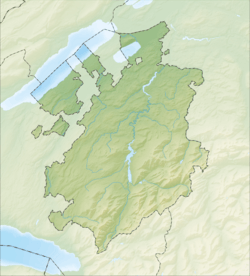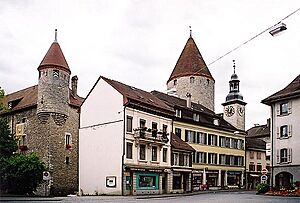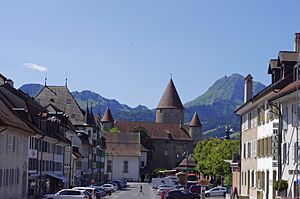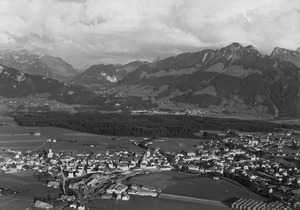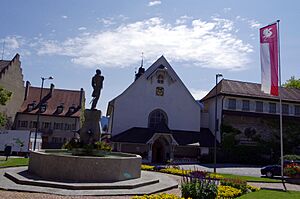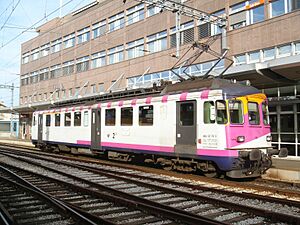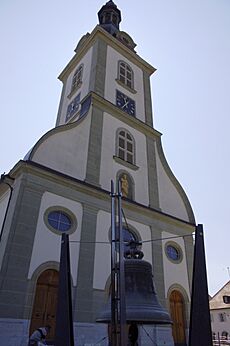Bulle facts for kids
Quick facts for kids
Bulle
|
||
|---|---|---|
 |
||
|
||
| Country | Switzerland | |
| Canton | Fribourg | |
| District | Gruyère | |
| Area | ||
| • Total | 23.86 km2 (9.21 sq mi) | |
| Elevation | 771 m (2,530 ft) | |
| Population
(Dec 2020 )
|
||
| • Total | 24,412 | |
| • Density | 1,023.13/km2 (2,649.9/sq mi) | |
| Postal code |
1630 Bulle, 1635 La Tour-de-Trême
|
|
| Localities | Bulle, La Tour-de-Trême | |
| Surrounded by | Echarlens, Gruyères, Morlon, Le Pâquier-Montbarry, Riaz, Vuadens | |
Bulle is a lively town in the canton of Fribourg in Switzerland. It's part of the Gruyère district, famous for its cheese! In 2006, Bulle joined with the nearby town of La Tour-de-Trême.
Contents
Discovering Bulle's Past
How Old is Bulle?
Bulle was first mentioned way back in the 9th century as Butulum. Later, around 1200, it was called Bollo. The town used to have a German name, Boll, but it's not used anymore.
Not much is known about Bulle's very early days. In 1995, archaeologists found part of a large burial mound. This mound dates back to the early Hallstatt culture, a time when people lived here long, long ago.
Bulle in the Middle Ages
During the Early Middle Ages, Bulle had an important church. This church, St. Eusebius, was probably built in the 6th or 7th century. It served a very large area.
Over time, this large church area was split into smaller ones. But Bulle's church remained important for the region until the 16th century. Bulle likely came under the rule of the Bishop of Lausanne early on.
The Counts of Gruyères also had some power in Bulle. This led to many disagreements between the counts and the bishop. But the bishop always won, and the counts lost their rights in Bulle.
Even by the 12th century, Bulle was a key place for trade. In 1195/96, a count even moved a market to Bulle to help it grow. At first, Bulle was just a group of homes around a church and maybe a castle.
In the 13th century, bishops realized Bulle was vital for their income. They also needed it to manage and protect the area. So, between 1231 and 1239, Bishop Boniface built a city wall around Bulle.
A castle was built soon after, probably between 1273 and 1301. Its main part was a tall tower, about 33 meters (108 feet) high. This tower guarded the south gate of the city.
Throughout the Middle Ages, bishops chose two officers to run the town. These were the castellan and the mayor. The de Bulle family held the mayor's job for a long time.
People in Bulle gained more freedoms and rights over the centuries. They had similar rights to citizens in Lausanne. Around 1350, many towns in the area lost their importance. But Bulle stayed strong because of its good location and the bishops' support. It even recovered quickly after a big fire in 1447.
Bulle in Newer Times
A big moment for Bulle was during the Burgundian Wars in 1476. Bulle made a deal with the city of Fribourg. Because of this, it was not attacked after a major battle.
In 1536, when the Bernese army took over Vaud, the Bishop of Lausanne fled to Fribourg. He put Bulle under Fribourg's protection. This helped Bulle stay Catholic.
However, Fribourg's protection soon turned into control in 1537. A new ruler, called a bailiff, was sent from Fribourg to govern Bulle from the castle.
The time from 1536 to 1798 was mostly peaceful. The town grew a little outside its walls. Bulle became a major center for making and selling cheese. It was a main hub for cheese sent to France.
In the 17th century, a chapel in Bulle became a popular place for pilgrimage. Many people visited it. In 1665, a group of monks called the Capuchins took over the chapel. They made it bigger and built a convent.
In the 18th century, the chapel's popularity slowly faded. A new church was built in 1750-51 because the old one was too small. The castle was also updated between 1763 and 1768.
From the 18th Century to Today
Towards the end of the 18th century, Bulle became important in the local government. A man named Pierre-Nicolas Chenaux held meetings in Bulle before a revolt in 1781.
During the French invasion in 1798, many Bulle residents supported the revolution. They raised a "liberty tree" and chose a new committee to run the town.
Bulle wanted to join the French-backed Lemanic Republic. But it became part of the Helvetic Republic's Canton of Fribourg instead. Bulle also got into a lot of debt during the French occupation.
On April 2, 1805, a huge fire destroyed almost the entire city. But Bulle was quickly rebuilt. Most of the old streets were kept. A large marketplace was created by not rebuilding one row of houses.
The town's grain storage building was rebuilt fast. The town hall followed in 1808, and the church in 1816.
Throughout the 19th century, Bulle often disagreed with the conservative government. They supported a more liberal constitution, which was adopted in 1831.
Later, the conservatives regained power. This led to more opposition, and Bulle was a key center for it. In January 1847, there was a rebellion in Bulle. The mayor was even put in prison.
After a short civil war called the Sonderbund War, Bulle became the capital of the Gruyère district in 1848. The 19th century saw many clashes between different political groups in Bulle.
Both groups tried to show off with big projects. One group built a railway line and started a bank. The other group also started a newspaper and another bank.
From the mid-19th century to 1970, one political party usually had the most power in Bulle. During World War II, Bulle had a notable event. In 1944, some government inspectors were attacked by a crowd. They had to hide in the castle for safety. Later, many people involved were punished.
Bulle's Location and Landscape
Bulle covers an area of about 23.86 square kilometers (9.21 square miles). A large part of this land, about 42%, is used for farming. Forests cover about 31.6% of the area.
About 25.3% of Bulle is covered by buildings and roads. A small part, 0.6%, is rivers or lakes. The town is the capital of the Gruyère district. It sits on a hill about 770 meters (2,526 feet) high, next to the Trême river.
Bulle's Coat of Arms
The blazon of Bulle's coat of arms shows a red ox walking on a silver background, with a red section below. This ox is a symbol for which the town is named.
Who Lives in Bulle?
Bulle has a population of about 26,000 people. About 29.8% of the people living here are from other countries. In the last 10 years (2000–2010), the population grew by 27.2%.
Most people in Bulle (about 85.1%) speak French as their main language. Portuguese is the second most common language, and German is third.
About 25.3% of the population are children and teenagers (0–19 years old). Adults (20–64 years old) make up 60.5%, and seniors (over 64 years old) are 14.2%.
The historical population of Bulle has grown a lot over the years:

Important Places in Bulle
Bulle has several places that are considered very important to Switzerland's history and culture. These include:
- The Notre-Dame De Compassion Chapel
- The Baillival Castle
- The Halle Landi
- The Gruérien Museum
The entire old town of Bulle is also a protected heritage site.
What to See in Bulle
Downtown Bulle is full of shops and offices. It has a train and bus station (TPF) with regular service to Fribourg. There's also an old castle that was turned into a prison. You'll see a sculpture of a bull in a traffic circle near the bus station. This bull is a symbol for the town's name!
Bulle's Economy
Bulle is a busy place for jobs. In 2010, the unemployment rate was 4.9%. Many people work in different areas:
- Primary sector: This includes farming and forestry.
- Secondary sector: This involves manufacturing and construction.
- Tertiary sector: This is the largest sector, including sales, transportation, hotels, restaurants, finance, education, and healthcare.
Bulle brings in more workers than it sends out. About 2.2 workers come into Bulle for every one who leaves. Most people (66.1%) use a private car to get to work. About 8% use public transportation.
Getting Around Bulle
Bulle is a central hub for the local train and bus network. It has the main offices and workshops for the Transports publics Fribourgeois (TPF) company. The modern station connects different train lines and many bus routes. You can also easily connect to other popular train lines from here.
Religion in Bulle
According to the 2000 census, most people in Bulle (75.7%) are Roman Catholic. About 5.6% belong to the Swiss Reformed Church. There are also smaller groups of other Christian faiths, as well as Islamic, Buddhist, and Hindu residents. About 5.19% of the population do not belong to any church.
Learning in Bulle
Education is important in Bulle. About 28.8% of the population has finished upper secondary education. About 10.2% have gone on to higher education, like university.
The Fribourg school system starts with one year of optional Kindergarten. Then, there are six years of Primary school. After that, students have three years of required lower Secondary school. They are grouped by their abilities.
After lower Secondary, students can choose to go to a three or four-year optional upper Secondary school. This can be a gymnasium (which prepares for university) or a vocational program. After upper Secondary, students can go to a Tertiary school or start an apprenticeship.
In the 2010–11 school year, there were over 6,200 students in Bulle. The town has a library called Bibliothèque de Bulle. In 2008, it had 78,000 books and other items.
Sports in Bulle
FC Bulle is the town's football (soccer) club.
Famous People from Bulle
Many notable people have connections to Bulle, including:
- Jean Crotti (1878–1958), a French painter.
- Isolde Liebherr (born 1949), a Swiss businesswoman.
- Erhard Loretan (1959–2011), a famous mountain climber.
- Christina Liebherr (born 1979), an equestrian and Olympic medalist.
- Jean-François Cuennet (born 1961), a ski mountaineer and runner.
- Gaëlle Thalmann (born 1986), a football goalkeeper.
- Jason Dupasquier (2001–2021), a racing motorcyclist.
See also
 In Spanish: Bulle (Friburgo) para niños
In Spanish: Bulle (Friburgo) para niños




